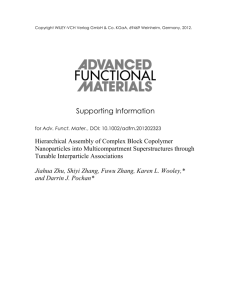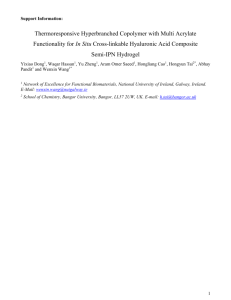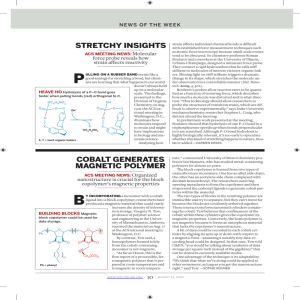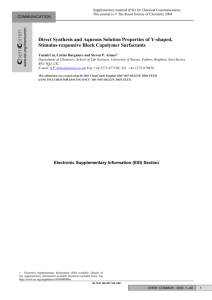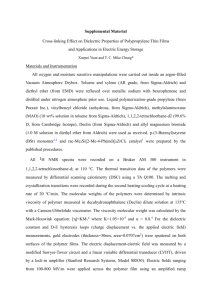Acyclic Diene Metathesis (ADMET) Copolymerization. Controlled Diene Insertion in Poly[ (hexamethyltrisiloxanediyl)
advertisement
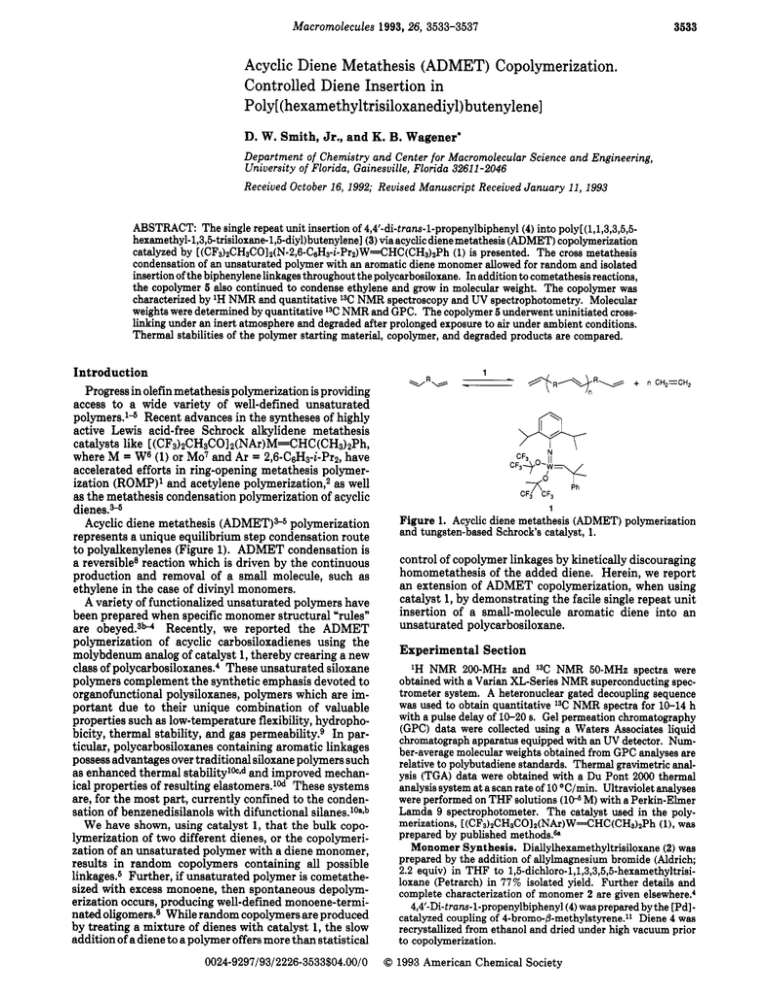
3533 Macromolecules 1993,26, 3533-3537 Acyclic Diene Metathesis (ADMET) Copolymerization. Controlled Diene Insertion in Poly[(hexamethyltrisiloxanediyl)butenylene] D. W. Smith, Jr., and K. B. Wagenerl Department of Chemistry and Center for Macromolecular Science and Engineering, University of Florida, Gainesuille, Florida 32611 -2046 Received October 16, 1992; Revised Manuscript Received January 11, 1993 ABSTRACT: The single repeat unit insertion of 4,4’-di-trans-l-propenylbiphenyl(4) into poly[ (1,1,3,3,5,5hexamethyl-l,3,5-trisiloxane-l,5-diyl) butenylene] (3) via acyclicdiene metathesis (ADMET)copolymerization (1) is presented. The cross metathesis catalyzed by [(CF~)~CH~COIO(N-~,~-C~H~-~-P~~)W==CHC(CH~)~P~ condensation of an unsaturated polymer with an aromatic diene monomer allowed for random and isolated insertion of the biphenylene linkagesthroughout the polycarbosiloxane. In addition to cometathesis reactions, the copolymer 5 also continued to condense ethylene and grow in molecular weight. The copolymer was characterized by lH NMR and quantitative 13C NMR spectroscopy and UV spectrophotometry. Molecular weights were determined by quantitative 13CNMR and GPC. The copolymer 5 underwent uninitiated crosslinking under an inert atmosphere and degraded after prolonged exposure to air under ambient conditions. Thermal stabilities of the polymer starting material, copolymer, and degraded products are compared. Introduction Progress in olefin metathesis polymerization is providing access to a wide variety of well-defined unsaturated polymers.l4 Recent advances in the syntheses of highly active Lewis acid-free Schrock alkylidene metathesis catalysts like [(CF3)2CH3COl2(NAr)M=CHC (CH3)zPh, where M = W8 (1) or Mo7 and Ar = 2,6-C,&-i-Pr2, have accelerated efforts in ring-opening metathesis polymerization (ROMP)’ and acetylene polymerization,2 as well as the metathesis condensation polymerization of acyclic dienes.Acyclic diene metathesis (ADMETlS5 polymerization represents a unique equilibrium step condensation route to polyalkenylenes (Figure 1). ADMET condensation is a reversible8 reaction which is driven by the continuous production and removal of a small molecule, such as ethylene in the case of divinyl monomers. A variety of functionalized unsaturated polymers have been prepared when specific monomer structural “rules” are obeyed.3” Recently, we reported the ADMET polymerization of acyclic carbosiloxadienes using the molybdenum analog of catalyst 1, thereby crearing a new class of polycarbosiloxanes.4 These unsaturated siloxane polymers complement the synthetic emphasis devoted to organofunctional polysiloxanes, polymers which are important due to their unique combination of valuable properties such as low-temperature flexibility, hydrophobicity, thermal stability, and gas permeability.9 In particular, polycarbosiloxanes containing aromatic linkages possess advantages over traditional siloxane polymers such as enhanced thermal stabilitylkId and improved mechanical properties of resulting elastomers.10d These systems are, for the most part, currently confined to the condensation of benzenedisilanols with difunctional silanes.10aSb W e have shown, using catalyst 1, that t h e bulk copolymerization of two different dienes, or the copolymerization of an unsaturated polymer with a diene monomer, results in random copolymers containing all possible linkages.6 Further, if unsaturated polymer is cometathesized with excess monoene, then spontaneous depolymerization occurs, producing well-defined monoene-terminated oligomers.8 While random copolymers are produced by treating a mixture of dienes with catalyst 1, the slow addition of a diene to a polymer offers more than statistical 1 Figure 1. Acyclic diene metathesis (ADMET) polymerization and tungsten-based Schrock’s catalyst, 1. control of copolymer linkages by kinetically discouraging homometathesis of the added diene. Herein, we report an extension of ADMET copolymerization, when using catalyst 1, by demonstrating the facile single repeat unit insertion of a small-molecule aromatic diene into an unsaturated polycarbosiloxane. Experimental Section lH NMR 200-MHz and 13C NMR 50-MHz spectra were obtained with a Varian XL-Series NMR superconducting spectrometer system. A heteronuclear gated decoupling sequence was used to obtain quantitative I3C NMR spectra for 10-14 h with a pulse delay of 10-20 8. Gel permeation chromatography (GPC) data were collected using a Waters Associates liquid chromatograph apparatus equipped with an UV detector. Number-average molecular weights obtained from GPC analyses are relative to polybutadiene standards. Thermal gravimetric analysis (TGA) data were obtained with a Du Pont 2000 thermal analysis system at a scan rate of 10 “C/min. Ultraviolet analyses were performed on THF solutions (1WM) with a Perkin-Elmer Lamda 9 spectrophotometer. The catalyst used in the polymerizations, [(CFs)2CHsCOIz(NAr)W=CHC(CHs)zPh(l),was prepared by published methods.& Monomer Synthesis. Diallylhexamethyltrisiloxane (2) was prepared by the addition of allylmagnesium bromide (Aldrich; 2.2 equiv) in THF to 1,5-dichloro-1,1,3,3,5,5-hexamethyltrisiloxane (Petrarch) in 77% isolated yield. Further details and complete characterization of monomer 2 are given elsewhere.‘ 4,4’-Di-trans-l-propenylbiphenyl(4) was prepared by the [Pdlcatalyzed coupling of 4-bromo-8-methylstyrene.11Diene 4 was recrystallized from ethanol and dried under high vacuum prior to copolymerization. 0024-9297/93/2226-3533$04.00/00 1993 American Chemical Society Macromolecules, Vol. 26,No. 14, 1993 3534 Smith and Wagener Polymerization. Poly[(hexamethyltrisilo~ediyl)butenylenel (3) was prepared by the addition of [(CF~)ZCH~COIZ(NA~)W=CHC(CH3)zPh(1) (1 equiv) to neat monomer 2 (670 equiv), under Nz,with stirring for 30 min in the bulk. Upon addition, rapid evolution of ethylene occurred, and the reaction was continued under intermittent vacuum for several hours until a noticeable increase in viscosity was observed. Quantitative I 3 C NMR integration indicated 67 % trans geometry, and end-group analysis (integrationof terminalvs internal vinylic carbon signals) revealed M,,= 7650 (DP 30). GPC (relativeto polybutadiene standards) gave MJM,,= 1.7. Further details and complete characterizationof high molecular weight polymer 3 are reported el~ewhere.~ Poly[ (hexamethyltrisiloxanediyl)butenylene-co-biphenylene] (5) was prepared by the addition of biphenyldiene 4 (75 equiv vs 1) in dry, deolefinated,and degassed toluene (0.1 M) at room temperature over a period of 1.5 h to the reaction mixture (containing active catalyst) of polymer 3 in 5 mL of toluene. Upon dilution of polymer 3 containingactive catalyst, 11 mol % hexamethyltrisiloxanylcyclonon-7-ene (6) was produced immediately due to a rapid backbiting reaction, the details of which have been di~cussed.~ The solution was stirred for 0.5 h under NPand then slowly evacuated and heated over 17 h, giving a viscous oil which could only be magnetically agitated at 50 "C. Bulk copolymerization was continued for several hours until stirring was no longer possible. Samples from the copolymer reaction mixture were dissolved in CDCl3and THF and analyzed by NMR and GPC, respectively. The copolymer was found to contain 16 mol 7% biphenylene repeat unit by 13C NMR spectroscopy compared to 10 mol % of 4 added (or -13 mol 7% vs polymer repeat unit after subtractingpercent cyclics formed). Pure copolymer samples were obtained by washing with MeOH and filtering over alumina, giving a light green viscous oil which resisted flow at temperatures exceeding 80 "C. Quantitative13C NMR integration indicated 70% trans geometry for the 3-3 linkages, whereas only the E isomer was detected for the 3-4 linkages. GPC (relative to polybutadiene standards)gave M,, = 27 000 and MJM, = 1.9. It had the following spectral properties: IH NMR (200 MHz, CDC13) 6 0.087 (s), 0.15 (s), 1.49 (m, allylic 3-3), 1.75 (m, allylic 3-4), 5.34 (m,trans vinylic 3-3), 5.33 (m,cis vinylic 3-31, 6.28 (m, E isomer, vinylic 3-4), 7.37 (m, aromatic),7.49 (m,aromatic);I3C NMR (50MHz,CDCl3) 8 4 . 1 6 , 2 t 1 - 1.28, 19.55,24.43, 25.67,122.49, 122.80,124.05, 124.13, 125.89, 126.82, 126.88,128.52. Results and Discussion We have undertaken a study to modify polymers by the equilibrium metathesis condensation of small-molecule dienes with well-defined unsaturated polymers. Degenerate interchain metathesis is known to occur during ADMET polymerizations where trans olefin geometry increases with the extent of r e a ~ t i o n .As ~ ~previously ~~ mentioned, bulk metathesis condensation, using catalyst 1, occurs between two different hydrocarbon dienes, or with diene and polyalkenylene, giving various random copolymers based on feed Copolymers containing main-chain aromatic groups were also formed when various bulk mixtures of 1,9-decadiene and 1,Cdi-1-propenylbenzene were treated with catalyst l . 5 b However, the copolymerization involving an aromatic diene gave only low molecular weight ( M , 3000) copolymers where it was shown that the homometathesis (i.e., dimerization and trimerization) of the dipropenylbenzene monomer produced insoluble oligomers of poly@-phenylenevinylene) which limited ADMET condensation due to the intervention of the solid state.5b From these cometathesis results it was reasoned that high molecular weight copolymer structures containing regulated aromatic units could be obtained from the controlled addition of the aromatic diene to an unsaturated polymer, thereby avoiding its homometathesis. The reaction of a dilute solution of 4,4'-di-trans-lpropenylbiphenvl (4: Figure 2) with a,w-diallylpoly- - 3 x-n CHpCH, + 4 2y CHP-CHCH, t 5 'Y Figure 2. Synthesis of poly[(hexamethyltrisiloxanediyl)butenylene-co-biphenylene] . [(hexamethyltrisiloxanediyl)butenylene](3) was predicted to yield a copolymer with isolated linkages of the added diene. The simple idea of constructing the linkages desired in excess, prior to addition of the comonomer, 4, reduces the probability of structural irregularities such as dimerization of diene 4. Figure 2 illustrates the copolymerization reaction scheme. The homopolymerization of monomer 2 to polymer 3 has been reported el~ewhere.~Although the polymerization was purposely stopped before high polymer 3 was obtained, high molecular weight polymer 3 is easily achieved with longer reaction times when using catalyst 1 or the molybdenum analog. Prior to copolymerization, polymer 3 possessed an average M,, = 7650 (DP 30) as determined by quantitative 13CNMR end-group analysis and a M,IM, = 1.7 vs polybutadiene standards. The butenylene linkages in polymer 3 contained a 67 % average trans geometry by 13CNMR, which is typical for ADMET polymerizations limited by reaction time.L4 Since ADMET polycondensation, catalyzed by 1, produces structurally pure and linear polymers void of contaminating byproducts, polymer 3 possessed well-defined sitas of unsaturation. These sites are further reactive toward continued metathesis condensation, and therefore polymer 3 did not require isolation or purification. Carbosiloxane polymer 3 is an attractive candidate for the cometathesis condensation with the very rigid smallmolecule diene, 4,4'-di-trans-l-propenylbiphenyl(4).For example, an insoluble solid was produced within minutes when attempting to homocondense diene 4 by treatment with catalyst 1 in toluene. Only the partially soluble ADMET dimer of 4 was confirmed by 1H NMR spectroscopy. The trisiloxane linkage in polymer 3 features two Si-0 bonds per repeat unit which impart excellent solubility and low-temperature flexibility to the backbone.12 The addition of aromatic diene 4 (13 mol ?6 vs 3 repeat unit) to polymer 3 in the presence of active catalyst produced from 1resulted in the isolated incorporation of the biphenylene linkage. Resonances indicative of diene 4 dimerization, i.e., stilbene signals, were not detected in the 'Hor 13CNMR spectra (Figure 3). Furthermore, NMR analysis of the. copolymer revealed that propagation proceeded to the extent that the molar concentration of terminal end groups fell below the limit of detection for - Macromolecules, Vol. 26, No. 14, 1993 ADMET Copolymerization 3535 Copolymer prcducts after mblenf dsgrodstion 7 9 'CDCI, 1 MI 14 5 I ie 12 14 16 18 ZE 22 Volume (ml) I Figure 4. Gel permeation chromatography (GPC) of polymer 3 (containing cyclic compound 6)) copolymer 5, and ambient degradation products from 5. 1 TMS 2 7 1 Ill I 6 \ 240 280 320 360 '.- 400 440 Wavelength (nm) Figure 5. Normalized UV spectra of biphenylene diene 4 and copolymer 5. 140 120 100 BO 60 40 20 0 PPM Figure 3. Quantitative 50-MHz 13C NMR spectra of polymer 3, diene 4,and copolymer 5. NMR end-group analysis (see Figure 3). Terminal vinyl carbon signals present in polymer 3 are resolved in the 13C NMR spectrum yet absent in the spectrum for copolymer 5. Clearly, in addition to incorporation of diene 4 into polymer 3, terminal olefin condensation also continued and the molecular weight increased substantially. Figure 3 also displays the 13CNMR spectrum for diene 4. Every nonequivalent carbon was identified in the copolymer based on the easily assigned carbon signals for polymer 3 and biphenyldiene 4. The average trans content of the butenylene linkages contained in the trisiloxane repeat unit did not significantly increase during the copolymerization (70% trans), whereas the biphenyleneallylsilane connections contained only one geometric isomer by IH and 13C NMR spectroscopy (see Figure 3) for which the E isomer is assigned. The 'H NMR signals for the biphenylene-allylsilane connections are found at 6.28 ppm which is consistent with other systems containing an (E)+alkylstyrene unitssb Comparison of the three spectra in Figure 3 shows conclusively that single repeat unit insertion of diene 4 was achieved. Resonances corresponding to the propenyl carbons in 4 (signals 1, 2, and 5 in the center spectrum) are absent in the 13C NMR spectrum for the copolymer, and new resonances for the vinylic (signal 10, lower spectrum) and allylic (signal 5 ) carbons connecting the aromatic ring of 4 to the allylsilane carbon of 3 appear. The vinylic carbon, j3 to the aromatic ipso carbon, however, is not resolved in the NMR spectrum and is most likely contained within one of the aromatic signals. The 13C NMR spectra in Figure 3 also indicate that metathesis backbiting reactions occurred when polymer 3 was diluted, as observed previ~usly.~ Carbon signals at 20.3 (signal 4) and 121.3 ppm (signal 7)) found in both spectra for the homopolymer 3 and copolymer 5, correspond to the allylic and vinylic carbons, respectively, of the ninemembered cyclic, hexamethyltrisiloxanylcyclonon7-ene (6). Only the cis isomer is formed in solution; however, the trans isomer of this cyclic backbiting product from polymer 3 has been previously isolated from the bulk? Quantitative 13C NMR revealed that 11 mol % cyclics formed upon initial dilution of polymer 3, and this quantity did not significantly change throughout the copolymerization. Ring/chain equilibrium is rapidly obtained for active polymer 3 in solution where the extent of cyclization is dependent upon the relative concentrations of the polymer and cyclic product. Cyclosiloxalkene 6 has been produced in greater concentrations (36 mol % ) for more dilute solutions where equilibrium is reached in less than 5 min.4 Analysis by GPC further supports copolymer formation by exhibiting a monomodal distribution representing an average M, = 27 000 (relative to polybutadiene standards) and M,IM, = 1.9 as predicted for step condensation polymerizations (Figure 4). The aromatic diene 4 was not detected by GPC analysis of the copolymer (5) reaction mixture.13 This evidence indicates that essentially quantitative insertion of diene 4 into polymer 3 was achieved. Integration of the aromatic signals in the 1H and 13CNMR spectra vs the butenylene signals also suggests that the degree of incorporation of the biphenylene unit into polymer 3 was quantitative. The copolymer was examined further by UV spectroscopy, and ita spectrum was compared to that of aromatic diene 4, as illustrated in Figure 5. Pure 4,4'-di-truns-lpropenylbiphenyl(4) exhibits a ,A, = 306 nm (c = 50 600 cm-' mol-' L) compared to a ,A = 317 nm for the copolymer. The slight bathochromic shift in ,A for the copolymer is expected due to electronic pert~rbationsl~ Macromolecules, Vol. 26, No. 14, 1993 3536 Smith and Wagener . r- g 80 -1 40 4 i\ 50- i -:Of 50 Copolymer products after ambient degradation . 200 350 Tamperature \ 500 i-CI Figure 6. Thermal gravimetric analysis (TGA)of polymer 3 and copolymer 5 in Nz (10 OC/min scan rate). from the allylic silicon atom in the copolymer. Allylsilane perturbation, or hyperconjugation, derived from the "8donor effect" is well-known in organic chemistry due to the reactivity of allylsilanes toward various ele~trophiles.~5 The copolymer absorbance cannot be attributed to biphenylene dimerization, which results in a significantly more conjugated stilbene linkage (e.g., 4,4'-diphenylstil= 360 nm).l6 Pure homopolymer 3 bene exhibits a ,A, exhibits a weak absorbance in the UV spectrum with a ,,A = 292 nm and is not resolved in the copolymer due to the strong absorbing biphenylene linkages. Although the shoulder near 360 nm for the copolymer is indicative of trace dimerization of the biphenylene, these linkages are not observed in the NMR spectrum. The thermal stability and extent of decomposition of copolymer 5 and polymer 3 are compared in Figure 6.The thermal stability of polymer 3 in nitrogen is only slightly improved by the incorporation of the biphenylene linkages. Some weight loss begins below 200 "C for the oligomer and at 377 "C (10% weight loss) rapid decomposition ensues for 3 compared to 420 "C (10% loss) for the copolymer 5. The copolymer decomposes to a maximum 90% of its original weight at 579 "C,whereas polymer 3 loses 100% of its weight at 500 "C. Copolymer 5 also underwent uninitiated cross-linking under an inert and otherwise ambient atmosphere (A > 400 nm). After standing at room temperature under argon for several days, copolymer 5 became a low-integrity rubbery film which was insoluble in THF. The crosslinking is light, however, as indicated by swellingcopolymer 5 in THF, where after 24 h nearly 80% extractables were obtained. Presumably, the chromophoric biphenylene linkages sensitize photo-cross-linking since the trisiloxane homopolymer, 3, does not undergo cross-linking and is in fact stable indefinitely under ambient conditions. Interestingly, copolymer 5 degraded to lower molecular weight products after prolonged standing in air (ca. weeks). Previously cross-linked copolymer 5 returned to an oily state and became mostly soluble (-95%) immediately without swellingin THF. Analysis of the degraded product by GPC revealed various oligomers representing a substantialdecrease in molecular weight (Figure 4). Thermal gravimetric analysis of the air-exposed product (Figure 7) exhibited a much greater loss in thermal stability where consistent weight loss began at 150 " C (10% weight loss at 208 "C). Presumably, the biphenylene-induced photocross-linking that is prevalent under an inert atmosphere is accelerated in air to the point of degradation since homopolymer 3 is completely stable under prolonged exposure to air. Conclusions Single repeat unit insertion of an aromatic diene into an unsaturated polycarbosiloxane was achieved by the cometathesis condensation of an aromatic diene with an unsaturated polymer. The molecular weight of the copolymer was significantly increased during cometathesis due to continued metathesis condensation of terminal olefins. Characterization of the copolymer by NMR and UV spectroscopy and GPC suggests that the biphenylene units were predominantly isolated. The copolymer exhibited only a slight enhancement in thermal stability from the homopolymer and, unlike the homopolymer, underwent uninitiated cross-linking under an inert atmosphere. The copolymer further degraded after prolonged exposure under ambient conditions. Acknowledgment. We thank the National Science Foundation (Grant DMR-8912026)for their support of this work. We are also very thankful to J. Konzelman and J. M. Boncella for catalyst synthesis and to A. S. Gamble and J. M. Boncella for donation of 4,4'-di-tram-lpropenylbiphenyl. Thanks also to J. E. O'Gara for helpful advice in the preparation of this manuscript. References and Notes (1) (a) Komiya, Z.;Pugh, C.; Schrock, R. R. Macromolecules 1992, 25,3609. (b)Bazan, G. C.; Schrock,R. R.;Cho, H.-N.; Gibson, V. C. Macromolecules 1991,24,4495. (c) Feldman,J.;Schrock, R.R. Prog.Znorg. Chem. 1991,39,1.(d)Bazan, G.C.; Khosravi, E.; Schrock,R. R.; Feast, W. J.; Gibson, V. C.; ORegan, M . B.; Thomas,J.K.;Davis, W. M.J.Am. Chem.Soc. 1990,112,8378. (e) Schrock, R.R.Acc. Chem. Res. 1990,23,158. (0Grubbs, R. H.;Gorman, C. B.; Ginsburg, E. J.; Marder, S. R. Angew. Chem., Znt. Ed. Engl. Adu. Mater. 1989,28 (ll), 1571. For generalreviewsonROMP,see:(g) Ivin,K. J. OlefinMetathesis; Academic Press: New York 1983. (h) Grubbs, R. H.; Tumas, W. Science 1989,243,907.(i) Grubbs, R.H. In Comprehensive Organometallic Chemistry; Wilkinson,G., Ed.; Pergamon Preas, La.:Oxford, U.K., 1982; Vol. 8,pp 49+551. (2) (a) Fox, H. H.; Schrock, R.R. Organometallics 1992,11,2763. (b) Park, L.Y.; Stieglitz, S. G.; Crowe, W. M.;Schrock, R. R. Macromolecules 1991,24,3489.(c) Schlund, R.;Schrock, R. R.; Crowe, W. E. J. Am. Chem. SOC.1989,111,8004. (3) (a) Wagener, K. B.; Boncella, J. M.; Nel, J. G. Macromolecules 1991,24, 2649. (b) Wagener, K. B.; Brzezineka, K. Macromolecules 1991,24,5273.(c) Wagener,K.B.; Smith,D. W., Jr. Macromolecules 1991,24,6073.(d) Patton, J. T.; Boncella,J. M.; Wagener, K. B. Macromolecules 1992,25,3862. (4) Smith, D. W., Jr.; Wagener, K. B. Macromolecules 1993,26, 1633. Macromolecules, Vol. 26, No. 14, 1993 ( 5 ) (a) Wagener, K. B.; Nel, J. G.; Konzelman, J.; Boncella, J. M. Macromolecules 1990,23,6155.(b) Wolf, A.; Wagener, K. B. Polym. Prepr. (Am. Chem. Soc., Diu. Polym. Chem.) 1991,31 (l), 636. (6) For the tungsten-baaed catalyst,see: (a) Schrock, R. R.;DePue, R.T.; Feldman, J.; Schaverien, C. J.; Dewan, J. C.; Liu, A. H. J. Am. Chem. SOC.1988,110,1423.(b) Depue, R.T.; Schrock, R. R.;Feldman, J.; Yap, K.; Yang, D. C.; Davis, W. M.; Park, L.; DiMare, M.; Schofield, M.; Anhaus, J.; Walborsky, E.; Evitt, E.; Kruger, C.; Betz, P. Organometallics 1990, 9,2262. (c) Schrock, R. R.;Schaverien, C. J.; Dewan, J. C. J. Am. Chem. SOC. 1986,108,2771. (7) For the molybdenum-based catalyst, see: (a) Schrock, R. R.; Murdzek, J.S.;Bazan,G. C.;Robbins, J.;DiMare,M.;ORegan, M. J.Am. Chem. SOC.1990,112,3875.(b) Bazan, G. C.; Oskam, J. H.;Cho,H.-N.; Park,L. Y.; Schrock,R. R.J.Am. Chem. SOC. 1991,113,6899. (8) (a)Wagener,K.B.;Puta,R.;Smith,D.W., Jr.Makromo1. Chem., Rapid Commun. 1991,12,413. (b) Wagener, K. B.;Marmo, J. C. Macromolecules 1993,26,2137. (9) For reviews, see: (a) McGrath, J. E.; Yilgor, L. Adv. Polym. Sci. 1988,86. (b) Zeldin, M., Wynne, K. J., Allcock, H. R.,Eds. Inorganic and Organometallic Polymers (Macromolecules ADMET Copolymerization 3537 Containing Silicon, Phosphorus and Other Inorganic Elements); American Chemical Society: Washington, DC, 1988; pp 180-249 and references therein. (c) Zeigler, J. M., Fearon, F. W. G., Eds. Silicon-Based Polymer Science; American Chemical Society: Washington, DC, 1990, and references therein. (10) (a) Dvornic, P. R.; Lenz, R. W. Macromolecules 1992,25,3769. (b) Babu, G. N.; Newmark, R. A. Macromolecules 1991,24, 4503. (c) Graasie, N.;Macfarlane, I. G. Eur. Polym. J. 1978,14, 875. (d) For a review, see: Dvornic, P. R.;Lenz, R. W. High Temperature Siloxane Elastomers; Htithig & Wepf Verlag: New York, 1990. (11) 4,4’-Di-trans-l-propenylbiphenyl (4)was generously donated by J. M. Boncella and A. S. Gamble, Department of Chemistry, University of Florida, Gainesville, FL. (12) Homopolymer 3 (M,, = 15000) exhibite a glaaa transition temperature at -97 OC. See ref 4. (13) Cyclic compound 6 is not observed in the GPC of copolymer 5, when using UV detection (Figure 4),due to the great differences in their absorptivities. (14) Bock, H. Angew. Chem., Int. Ed. Engl. 1989,28,1627. (15) Chan, T.H.; Fleming, I. Synthesis 1979,761. (16) Drefahl, G.; Henkel, H. J. 2.Phys. Chem. (Leipzig) 1956,206.
